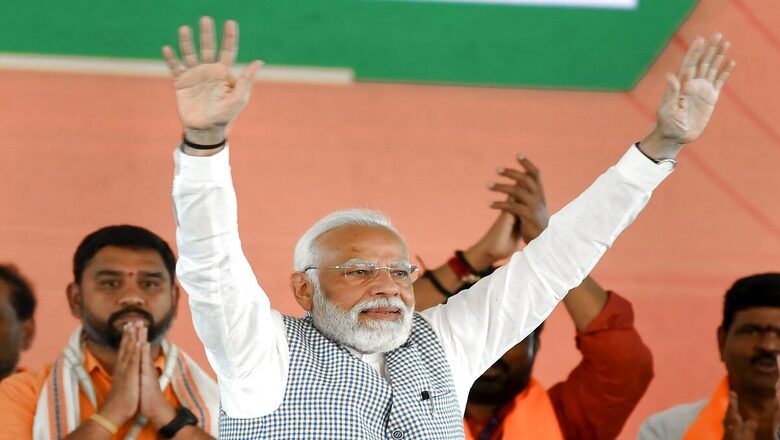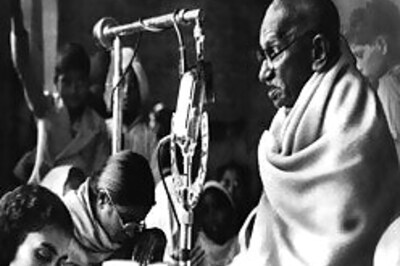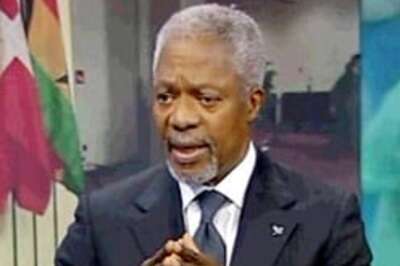
views
India is not just the oldest but the only civilisation that has a regenerative spirit and has survived various onslaughts of the past. With built-in resilience and adaptability, Indian civilisation has had a legacy of knowledge, philosophy and culture. These attributes of uniqueness have perhaps led India’s political, social, economic and cultural journey over the last many decades. Swadesh Singh’s book ‘Modian Consensus: The Rediscovery of Bharat’ takes us to India’s political journey over the last 150 years and rightfully captivates it into five consensus phases or frameworks that have driven India, particularly since the 1870s. The last of the five phases is the ongoing Modian Consensus around which the book has been designed, written and analysed.
The book makes an interesting pathway for the readers to navigate into the cultural and political history of India over the last 150 years. What is striking is the simplicity of the book for those readers who have rare or no interest in the politics of India. The book takes you on a journey from pre-independent to post-independent and contemporary India and how the consensus was “redefined, reinvented, readapted and repackaged” whenever the scope of “innovation, invention and regeneration” was reduced.
The book has been precisely divided into three sections, with each section dwelling upon an interesting aspect of consensus building in India. The first section takes into account the in-depth understanding of the word ‘consensus’ and how it was framed and designed in pre and post-independent India. The second section focuses on the three postulates of the Modian Consensus and how it has driven India over the last decade. The last and the third section draws upon various factors contributing to the establishment of the Modian Consensus along with discussing multiple challenges that the consensus encounters or can encounter in the future and the possible roadmap for the consensus to continue even after Modi.

Singh in his book has made a peculiar attempt and a visionary ideation in terms of not only tracing the changing dynamics of politics in India but also in terms of predicting, placing and relocating the politics of “New India” in its perspective, something that has remained untouched so far. Undoubtedly, such a rigorous understanding of politics comes with Singh’s close association with party politics in India and his excellent academic rigour to present his thoughts with so much ease. Each of the five consensus phases in the book has been discussed along with its chief characteristics, challenges and postulates, which accounts for an easy and striking comparison of India under different leaders.
Moving into the intricacies of the book, the first section has been divided into three chapters. The first chapter explores the meaning of the word ‘consensus’ from multiple perspectives. It calls for an ‘agreement’ when a sizeable section of the society starts following or leaning towards a particular idea, thought or framework. Alongside, it also establishes that this consensus building needs to be reinvented from time to time or else it ends or weakens the consensus in place.
Chapter two deals with the consensus that existed in pre-independent India and how this period from the 1870s to 1910 represents the Civilisational Consensus. During this time, India was under the colonial control of the British forces who had left no stone unturned to damage the cultural, political and social ethos of India. It was then realised that there was an urgent need to redefine the national identity of India, perhaps awakening ‘civilisational consciousness’ among people, which eventually formed the basis of the freedom movement in India. India has had a rich legacy of knowledge, philosophy and culture, that perhaps has saved the nation from the multiple onslaughts of the past. It was this realisation that emerged among people that ‘Indians are fit to rule themselves’ and no outsiders have the right to rule India, which eventually provided for an ideological foundation for the freedom movement, resulting in the formation of the Civilisational Consensus. At the same time, the author mentions that there were multiple efforts from the British side to weaken the emerging consensus by effectively applying the divide-and-rule policy along the fault lines of caste, religion, race and language.
Continuing with the pre-independent phase, the author in chapter two takes us to another consensus that was taking shape after the weakening of the Civilisational Consensus and the arrival of Mahatma Gandhi on the political fronts of India. Gandhi, undoubtedly was a pan-India leader whose aura and charisma had the potential to rally the masses. This Gandhian Consensus roughly lasted from 1920-1950 and led the last leg of the freedom movement. The three characteristics that defined the consensus were Gandhi’s three popular ideas – Satyagraha, non-violence and non-cooperation. However, the consensus did not last after the death of Gandhi owing to multiple fractures it witnessed along the lines of Hindu-Muslim unity, internal differences in the Congress, the end of the freedom movement and the rising and prominent position of Nehru within the Congress.
This leads us to the third chapter which discusses consensus building in post-independent India, which is largely driven by Nehru’s style of politics and hence called the Nehruvian Consensus. It roughly lasted from the 1950s to the 1980s and was characterised by three bulwarks – socialism, secularism and non-alignment. This phase saw a sharp deviation from the earlier two consensuses revolving around India’s civilisational value system to Western notions of governance as Nehru was highly inspired by Western ideas and principles. After Nehru, this consensus witnessed its worst form under his daughter Indira Gandhi whose methods and practices in politics led to the end of the Nehruvian Consensus. At that time, India saw the rise of the Bharatiya Janata Party (BJP), which was consistently alarming India about the three major threats – Islam, Christian conversions and communism.
This leads us to the fourth form of consensus in India – the Secular Consensus which lasted from 1990-2014. This phase was characterised by political instability, increased relevance of regional parties and appeasement of Muslims under the garb of secularism. The BJP during that time came up with its own version of “positive secularism”, however, when voted to power in 1998 under the leadership of PM Atal Bihari Vajpayee, it dropped its core agenda of Ram Mandir and Article 370 due to the impact of the ongoing Secular Consensus. However, the weakening of the Secular Consensus started with the Congress coming to power again in 2004 and committing some of its worst mistakes like rampant cases of corruption, coining the term ‘Hindu terror’, to introducing the Communal Violence Bill 2011 which deeply hurt the sentiments of the Hindu population and was considered the last nail in the coffin. At the same time, the Gujarat model of governance and development was making popular rounds across the country under the then Chief Minister Narendra Modi and the general public was getting convinced that a change was needed.
This leads us to the second and main section of the book where chapter four talks about the coming of the Modi government in 2014 and how the dynamics of politics changed ever since. Modi-led BJP government brought new hopes and aspirations among the general public through its schemes, policies and programmes which revolved around the three key postulates of Modian Consensus – cultural rootedness, assertive nationalism and welfare of all. Chapter five dwells upon how PM Modi ensured being rooted to India’s culture in all his actions. He displayed an uncompromising and unapologetic attitude and never bargained when it came to India’s ancient identity. He rather combined India’s ancient glory with his modern aspirations and led two successful tenures.
From taking yoga to the world stage to giving India’s G20 Presidency a global, local and vocal identity, PM Modi ensured it all. Similarly, chapter six takes us to another postulate of assertive nationalism. From adopting a ‘Nation-first’ approach to prioritising national security, from implementing “One Rank, One Pension” to effectively dealing with terrorism and expansionism, the last decade saw it all being assertively handled by PM Modi. The best display of the postulate was the abolition of Article 370 and revoking Article 35A in India’s interests. Thus, for PM Modi, integrity, sovereignty and dignity of India are of paramount significance and any hampering with it will result in stern actions. The last postulate of the Modian Consensus is ‘welfare of all’ which has been captured in chapter seven of the book. This principle is something that has connected PM Modi with the masses. It encapsulates various policies and programmes of the Modi government for different sections of the society. It ensures not just the welfare of the last person in the queue but also an effective blend of Antyodaya, corruption-free government and the use of technology. ‘Minimum government, maximum governance’ and the effective combination of capitalist and socialist models of economy has helped the Modi-led government to bridge the socio-economic divide.
The last and final section of the book provides for the establishment of the Modian Consensus and the simultaneous emergence of ‘New India’. The author here lays down different spheres which have witnessed the impact of the Modian Consensus, ranging from arts, cinema, and culture to cryptos, stocks, travel, food, influencers and startups. This consensus calls for participatory governance, innovation, effective use of social media and most importantly, a democratic system driven by people and not the other way round. The beauty of this consensus lies in the fact that even the Opposition and those who dislike Modi, are compelled to embark upon the footsteps of the Modian Consensus, probably because of the impact, outreach and success it has rendered for Modi and the BJP government.
However, needless to say, just like the other consensuses, even the Modian Consensus encompasses multiple challenges, some of which already exist and some that may exist in the future. In chapter nine of the book, the author adequately addresses the external and internal challenges that the consensus is likely to witness. Some of these notable challenges mentioned are propaganda-driven politics of multiple groups like the Islamists, Maoists, and liberal intellectuals trained in Western academic frameworks, the emergence of global issues similar to the Covid-19 pandemic or even conflicts and conspiracy arising from within the BJP. The handling of such challenges is likely to pave the way for the sustenance of the Modian Consensus in the years to come.
The tenth and last chapter of the book fundamentally draws upon the prospects and way ahead for the Modian Consensus where the author very aptly discusses the possibilities that may account for the continuity of this consensus. For ‘New India’ to be a ‘Vishwa Guru’ and leave its global footprints, it is essential that Modian Consensus adapts itself to the changing times, particularly in terms of giving spaces to independent voices in democratic India, making socio-economic democracy a priority and redefining the global world order driven by family system, community living, wellness, climate and environment.
Swadesh Singh’s ‘Modian Consensus: The Rediscovery of Bharat’ is an excellent attempt to bring together core aspects of Indian values, culture, and traditions that have a huge impact on the politics of the country today. There is a need for envisioning a collective dream for India, a dream which is rooted in India’s civilisational ethos and at the same time, has the potential to position India as a global leader – a Vishwa Guru, directing and guiding the world through the challenges of the modern world.
The author is the Assistant Professor of Political Science and International Relations at Deshbandhu College, University of Delhi. Views expressed in the above piece are personal and solely that of the author. They do not necessarily reflect News18’s views.




















Comments
0 comment